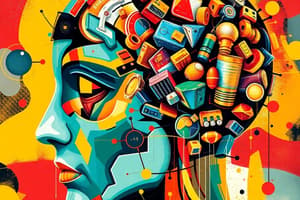Podcast
Questions and Answers
Which type of AI is specifically designed for a narrow range of tasks?
Which type of AI is specifically designed for a narrow range of tasks?
- Narrow AI (correct)
- General AI
- Adaptive AI
- Superintelligent AI
What is a major challenge associated with the proliferation of AI technologies?
What is a major challenge associated with the proliferation of AI technologies?
- Enhanced decision-making capabilities
- Job displacement (correct)
- Increased job opportunities
- Data transparency
Which field of AI aims to enable machines to understand and interact using human languages?
Which field of AI aims to enable machines to understand and interact using human languages?
- Neural Networking
- Machine Learning
- Robotics
- Natural Language Processing (correct)
What is a defining characteristic of Superintelligent AI?
What is a defining characteristic of Superintelligent AI?
Which of the following is NOT a type of Machine Learning?
Which of the following is NOT a type of Machine Learning?
What is a potential ethical issue raised by the use of AI?
What is a potential ethical issue raised by the use of AI?
Which application involves AI for detecting fraudulent activities?
Which application involves AI for detecting fraudulent activities?
What future trend in AI includes a focus on better transparency in decision-making?
What future trend in AI includes a focus on better transparency in decision-making?
Flashcards are hidden until you start studying
Study Notes
Definition
- Artificial Intelligence (AI) refers to the simulation of human intelligence in machines programmed to think and learn like humans.
Types of AI
-
Narrow AI:
- Specialized in a single task or a narrow range of tasks.
- Examples: Voice assistants (Siri, Alexa), recommendation systems.
-
General AI:
- Hypothetical AI that possesses the ability to perform any intellectual task that a human can do.
- Currently not achieved.
-
Superintelligent AI:
- An AI that surpasses human intelligence across a broad range of activities.
- Theoretical and not yet realized.
Key Concepts
-
Machine Learning (ML):
- Subset of AI that enables machines to learn from data and improve over time without explicit programming.
- Types:
- Supervised Learning
- Unsupervised Learning
- Reinforcement Learning
-
Deep Learning:
- A subset of ML involving neural networks with multiple layers that can learn complex patterns in large amounts of data.
-
Natural Language Processing (NLP):
- A field of AI focused on the interaction between computers and humans using natural language.
- Applications include chatbots and language translation.
Applications
-
Healthcare:
- Diagnostics, personalized medicine, drug discovery.
-
Finance:
- Fraud detection, algorithmic trading, credit scoring.
-
Transportation:
- Autonomous vehicles, traffic management systems.
-
Entertainment:
- Content recommendation, game AI.
-
Customer Service:
- AI chatbots, virtual assistants.
Challenges
-
Ethics:
- Issues around privacy, data security, and bias in algorithms.
-
Job Displacement:
- Potential loss of jobs due to automation.
-
Safety and Control:
- Concerns about AI systems making decisions without human oversight.
Future Trends
- Increased integration of AI in various sectors.
- Advances in explainable AI for better transparency in decision-making.
- Ongoing research in achieving general AI and addressing ethical concerns.
Definition
- Artificial Intelligence (AI) simulates human intelligence in machines, enabling them to think and learn like humans.
Types of AI
-
Narrow AI:
- Designed for a specific task or a narrow range of tasks.
- Examples include voice assistants (Siri, Alexa) and recommendation systems.
-
General AI:
- Hypothetical form of AI capable of performing any intellectual task that a human can.
- Currently, it has not been achieved.
-
Superintelligent AI:
- AI that greatly exceeds human intelligence across a variety of activities.
- This remains a theoretical concept, not yet realized.
Key Concepts
-
Machine Learning (ML):
- A subset of AI that allows machines to learn from data and enhance their performance over time without specific programming.
- Types include:
- Supervised Learning: Learns from labeled data.
- Unsupervised Learning: Identifies patterns in unlabeled data.
- Reinforcement Learning: Learns through trial and error to achieve specific goals.
-
Deep Learning:
- Subset of ML that utilizes neural networks with multiple layers to learn from complex data.
-
Natural Language Processing (NLP):
- A field dedicated to enabling interactions between computers and humans through natural language.
- Applications encompass chatbots, language translation, and sentiment analysis.
Applications
-
Healthcare:
- Used for diagnostics, personalized treatment plans, and drug discovery.
-
Finance:
- Includes applications such as fraud detection, algorithmic trading, and credit scoring.
-
Transportation:
- Development of autonomous vehicles and efficient traffic management systems.
-
Entertainment:
- Involves content recommendation engines and AI for gaming experiences.
-
Customer Service:
- Utilizes AI chatbots and virtual assistants to improve service efficiency.
Challenges
-
Ethics:
- Raises concerns about privacy, data security, and biases inherent in algorithms.
-
Job Displacement:
- Automation risks contributing to the loss of jobs across various sectors.
-
Safety and Control:
- Highlights the risks of allowing AI systems to make critical decisions without human oversight.
Future Trends
- Anticipated increase in AI integration across different industries.
- Research focuses on developing explainable AI to enhance transparency in decision-making.
- Ongoing efforts to pursue general AI capabilities while addressing ethical implications and concerns.
Studying That Suits You
Use AI to generate personalized quizzes and flashcards to suit your learning preferences.




